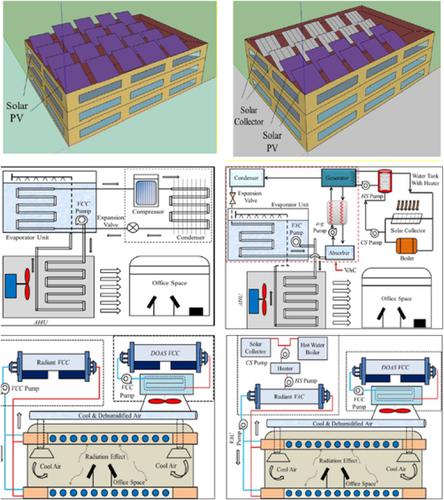当前位置:
X-MOL 学术
›
Int. J. Energy Res.
›
论文详情
Our official English website, www.x-mol.net, welcomes your
feedback! (Note: you will need to create a separate account there.)
Comparative assessment of different air‐conditioning systems for nearly/net zero‐energy buildings
International Journal of Energy Research ( IF 4.3 ) Pub Date : 2020-01-21 , DOI: 10.1002/er.5065 Gaurav Singh 1 , Ranjan Das 1
International Journal of Energy Research ( IF 4.3 ) Pub Date : 2020-01-21 , DOI: 10.1002/er.5065 Gaurav Singh 1 , Ranjan Das 1
Affiliation

|
This study deals with the performance of different air‐conditioning strategies for achieving the target of nearly/net zero energy in a medium‐scale building under various environmental conditions. In particular, vapour compression (VC), vapour absorption (VA), and integration of radiant cooling technology are analysed using renewable energy resources and solar photovoltaic (PV)‐based electricity. Four different kinds of air‐conditioning configurations are considered: VC‐based, VA‐based, VC‐radiant air‐conditioning technology with VC dedicated outdoor air system (DOAS) and VA radiant air‐conditioning technology with VC‐DOAS. Numerical model validations with the benchmark standards are done for VC‐ and VA‐based systems. In particular, annual electric consumption, electricity generation, thermal load generation among all configurations, emissions and solar fractions are studied. The present study shows that target of nearly/net zero‐energy building can be achieved in an efficient manner through radiant VC‐based system with VC‐DOAS for hot‐dry and composite (ie, hot‐dry with higher humidity) environment conditions. However, for warm‐humid environment, complete net zero is not possible, but up to 74% of net zero target can be assured with VC‐based radiant and DOAS. With respect to the conventional VC‐based system, the payback period assessment for the most suitable nearly/net zero building cooling system varies in the range of 5‐9 years, depending on the environmental conditions.
中文翻译:

接近/净零能耗建筑的不同空调系统的比较评估
这项研究涉及不同的空调策略的性能,以在各种环境条件下在中等规模的建筑物中实现接近/净零能耗的目标。尤其是,使用可再生能源和基于太阳能光伏(PV)的电力来分析蒸汽压缩(VC),蒸汽吸收(VA)和辐射冷却技术的集成。考虑了四种不同类型的空调配置:基于VC,基于VA,具有VC专用室外空气系统(DOAS)和VA的VC辐射空调技术VC-DOAS的辐射空调技术。对于基于VC和VA的系统,使用基准标准进行了数值模型验证。特别是,研究了所有配置中的年度用电量,发电量,热负荷,排放量和太阳能份额。本研究表明,对于热干和复合(即湿度较高的热干)环境条件,通过基于VC的辐射VC系统和VC - DOAS,可以有效地实现近零净零能耗的目标。但是,对于温暖潮湿的环境,不可能实现完全的净零目标,但是使用VC可以确保达到零净目标的74%基于辐射和DOAS的。对于传统的基于VC的系统,根据环境条件,最合适的近/净零建筑物制冷系统的投资回收期评估范围为5-9年。
更新日期:2020-01-21
中文翻译:

接近/净零能耗建筑的不同空调系统的比较评估
这项研究涉及不同的空调策略的性能,以在各种环境条件下在中等规模的建筑物中实现接近/净零能耗的目标。尤其是,使用可再生能源和基于太阳能光伏(PV)的电力来分析蒸汽压缩(VC),蒸汽吸收(VA)和辐射冷却技术的集成。考虑了四种不同类型的空调配置:基于VC,基于VA,具有VC专用室外空气系统(DOAS)和VA的VC辐射空调技术VC-DOAS的辐射空调技术。对于基于VC和VA的系统,使用基准标准进行了数值模型验证。特别是,研究了所有配置中的年度用电量,发电量,热负荷,排放量和太阳能份额。本研究表明,对于热干和复合(即湿度较高的热干)环境条件,通过基于VC的辐射VC系统和VC - DOAS,可以有效地实现近零净零能耗的目标。但是,对于温暖潮湿的环境,不可能实现完全的净零目标,但是使用VC可以确保达到零净目标的74%基于辐射和DOAS的。对于传统的基于VC的系统,根据环境条件,最合适的近/净零建筑物制冷系统的投资回收期评估范围为5-9年。











































 京公网安备 11010802027423号
京公网安备 11010802027423号